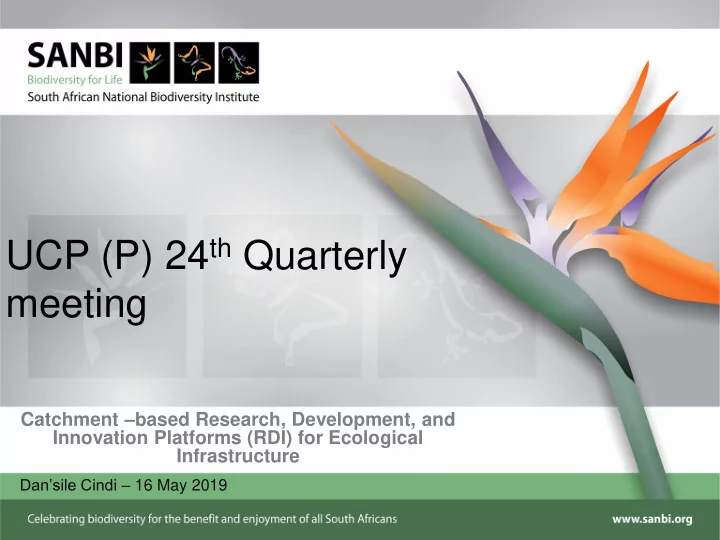

UCP (P) 24 th Quarterly meeting Catchment – based Research, Development, and Innovation Platforms (RDI) for Ecological Infrastructure Dan’sile Cindi – 16 May 2019
Ecological infrastructure is… • Naturally functioning ecosystems that deliver valuable services to people (SANBI, 2014) • nature’s equivalent of built infrastructure e.g. mountain catchments, rivers, wetlands, coastal dunes, spawning grounds, nodes and corridors of natural habitat • Many mountain ranges collect rain water and distribute it to millions of people through rivers. • Plants and animals help keep soil healthy to grow food. • Grasslands feed livestock and forests clean the air. • Wetlands purify water and reduce the impact of droughts and floods. • Nature is central to tourism and wellbeing, offering a number of opportunities for physical, spiritual and educational outdoor activities.
Examples of interventions for investing in EI Interventions Benefits Clear invasive alien plants especially in Increased water yield mountain catchments and riparian areas Rehabilitate wetlands Improved water quality through filtering of pollutants and toxins Maintain buffers of natural vegetation along Reduced flood damage streams and rivers Reinstate buffers of natural vegetation Reduced flood damage and improved water between agricultural crops and rivers or quality wetlands Conserve and maintain natural areas of Improved pollination of cultivated crops and vegetation on farms pest control Erosion control and appropriate management Reduced sediment load in dams of land use
EI provides a range of benefits, Investing in the rehabilitation and supporting and diversifying management of EI can generate livelihoods and reducing substantial numbers of long-term poverty. jobs, especially in rural areas. EI has the potential to Biodiversity underpins the supplement, sustain or substitute delivery of ecosystem services. for built infrastructure, and supports disaster risk reduction
DST/RDI project – Berg-Breede and uMzimvubu catchments Rationale: • Well established epistemic community in South Africa that has expertise relating to ecosystems and biodiversity, ecosystem services, and natural resources management more generally. • Requires improved coordination (avoid unnecessary overlap, better synergies, uptake and positioning)
Objectives
Why these catchments? • Both catchments were identified as a global biodiversity hotspot needing intervention and are within SWSA needing protection. • Important EI…underlying stock of asset. • Organised partnerships, collaborations…have been working in the catchment for more than 10 years. • Organised landowners, farmers… communities within the catchments.
Landscape approach • SANBI is able to work with other partners in building ecosystem resilience and easing biodiversity pressures at catchment level. • Support convening of communities of practice in or linked to the catchment e.g. learning exchanges. • Support governance structures that are involved with management of ecosystems and biodiversity. • Making the case for EI: extract successful lessons learnt from the catchment for documentation and replication elsewhere e.g. NBA 2018 case study
Enhancing research, innovation and impact through engaged Communities of Practice in key catchments associated with Strategic Water Source Areas • Partnership between SANBI/ DST and WRC in the period 2019 – 2022. • To create more resilient, more resourced, and more relational communities at both catchment and national scales, that are able to draw from the best that the research has to offer in the process of governing the equitable, productive and sustainable use of water resources and ecosystem goods and services. • To build on, scale up and refine catchment scale work piloted by SANBI and relevant partners in various catchments through supporting established CoP in key catchments associated with the SWSAs.
Clusters 1. Enable collaboration and learning in Strategic Water Source Areas across South Africa, informed by research, innovation and best practice. • Existing platforms will be scaled up as we build towards ensuring that the two platforms that have been seeded and supported through the existing DST partnership are self-sustaining. In addition, at least two new platforms will be created. 2. Consolidate a network of social process practice and Socio- Ecological Systems (SES) thinking practitioners across South Africa. 3. Strengthen and expand upon our practice of policy engagement and implementation capabilities and approaches.
RDI coordination For more information contact: SANBI - Dan’sile Cindi d.cindi@sanbi.org.za Tel: 012 843 5152 ERS – Nicky McLeod nicky@enviros.co.za Living Lands – Liezl le Roux Liezl@livinglands.co.za
Recommend
More recommend